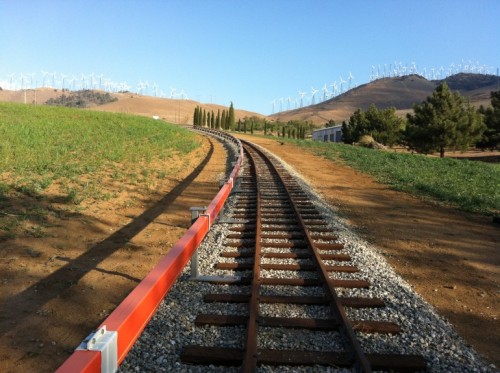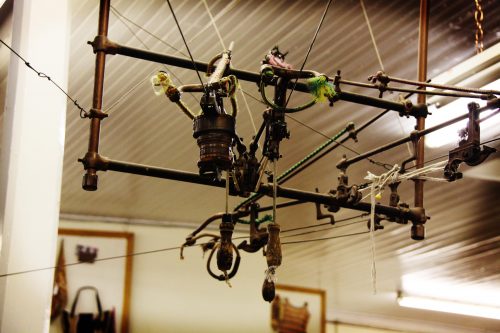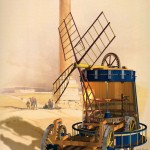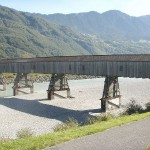“ARES is a rail-based technology that stores energy by raising the elevation of mass against the force of gravity and recovering the stored energy as the mass is returned to its original location. Specifically, ARES energy storage technology employs a fleet of electric traction drive shuttle-trains, operating on a closed low-friction automated steel rail network to transport a field of heavy masses between two storage yards at different elevations.”
The Flying Men of Yungas Valley
“In Bolivia’s jungles and steep cliffs the Yungas people do not walk. They fly. On ropes. Like birds. Faster than astronauts. These ‘birds’ are known as cocaleros, or coca harvesters. They use ropes to swing across the narrow valleys, suspended from ancient rusting pulleys.” Watch the video. Jerry, thanks for the link. Previously: Aerial ropeways: automatic cargo transport for a bargain.
Cash Ropeway in South Africa
Low-tech Magazine editor Shameez Joubert spotted this cash ropeway in Grahamstown, South Africa.
Cash ropeways were used in shops from the 1880s to the 1960s. They worked in a similar manner to large-scale cargo ropeways. Bicable cash transportation systems were powered by a catapult device or by separation of the wires, monocable systems were operated by a small electric motor.
The Cash Railway Website is dedicated to cash ropeways and similar systems, but it does not mention any ropeway still in use. The system in the South African shop was installed in the 1960s and it still works. Thank you, Shameez!
Aerial Ropeways in Nepal
“The gravity ropeway is an inexpensive and simple means of transportation. It operates by gravitational force without the use of external power. The gravity ropeway consists of two trolleys which roll on support tracks. These are attached to a control cable in the middle which moves in a traditional flywheel system. When the loaded trolley at the up-station is pulled downward by the force of gravity, the other trolley at the bottom-station is pulled up automatically by means of the control cable.
In principal the goods coming downward from the up-station must to be thrice as heavy as the up-going load. The sliding down of the trolley and its speed depends upon the angle of elevation made by the cables installed with the horizontal ground.
A flywheel with bearing and bracket is used as a brake to control the landing speed of the trolley at the bottom-station. Communication between top and bottom stations is done by tapping the wire rope. The operator at the top-station strikes the wire rope with a stick to send a wave signal through the wire rope to the operator at the down-station. The operator at the down-station then applies the hand brake to control the flywheel.”
Read more (building plans included). In-depth article: “Aerial ropeways: automatic cargo transport for a bargain“. Related: Water powered cable trains & (for those lacking mountains) Electric road trains 1901-1950.







